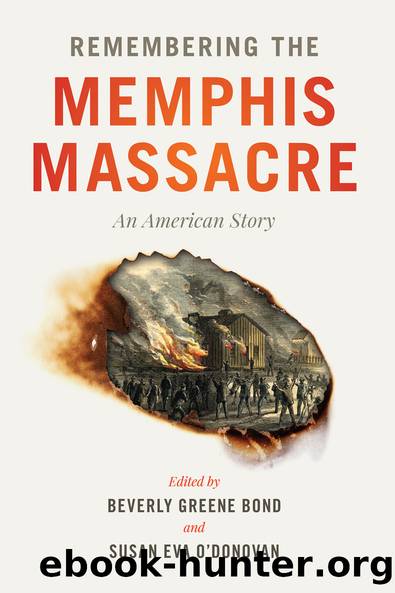Remembering the Memphis Massacre by Bond Beverly G.;O'Donovan Susan E.;

Author:Bond, Beverly G.;O'Donovan, Susan E.; [Неизв.]
Language: eng
Format: epub
Publisher: Lightning Source Inc. (Tier 3)
Published: 2020-07-04T21:00:00+00:00
NOTES
This chapter was first presented at âMemories of a Massacre: Memphis in 1866.â I am grateful to Beverly Greene Bond and Susan Eva OâDonovan for organizing this important conference and for inviting me to be a part of it. I also thank New York University Press and the University of North Carolina Press for permission to reprint portions of my earlier published work on this history.
1. On the history of this violence, see Stephen V. Ash, A Massacre in Memphis: The Race Riot That Shook the Nation One Year after the Civil War (New York: Hill and Wang, 2013). See also Hannah Rosen, Terror in the Heart of Freedom: Citizenship, Sexual Violence, and the Meaning of Race in the Postemancipation South (Chapel Hill: University of North Carolina Press, 2009), chaps. 1 and 2; Barrington Walker, âThis Is White Manâs Day: The Irish, White Racial Identity, and the 1866 Memphis Riots,â Left History 5 (Fall 1997): 31â55; Kevin R. Hardwick, ââYour Old Father Abe Lincoln Is Dead and Damnedâ: Black Soldiers and the Memphis Race Riot of 1866,â Journal of Social History 27 (Fall 1993): 109â28; Altina Waller, âCommunity, Class, and Race in the Memphis Riot of 1866,â Journal of Social History 18 (Winter 1984): 233â46; George C. Rable, But There Was No Peace: The Role of Violence in the Politics of Reconstruction (Athens: University of Georgia Press, 1984), 33â42; Bobby L. Lovett, âMemphis Riots: White Reaction to Blacks in Memphis, May 1865âJuly 1866,â Tennessee Historical Quarterly 37 (Spring 1979): 9â33; Patrick W. Riddleberger, 1866: The Critical Year Revisited (Carbondale: Southern Illinois University Press, 1979), 177â201; and James Gilbert Ryan, âThe Memphis Riots of 1866: Terror in a Black Community during Reconstruction,â Journal of Negro History 62 (July 1977): 243â57.
2. For their testimony, see affidavits of Rebecca Ann Bloom and Peter Bloom, in âAffidavits Taken before Commission Organized by the Freedmenâs Bureauâ (hereinafter fbc), in âMemphis Riots and Massacres,â U.S. Serial Set, no. 1274, House Report 101, 39th Cong., 1st sess., 351, 348.
3. Affidavit of Peter Bloom, ibid., 348.
4. Affidavit of Rebecca Ann Bloom, ibid., 351.
5. See testimony of Frances Thompson, 196â97; Lucy Smith, 197; Harriet Armour, 176â77; and Lucy Tibbs, 160â62, all ibid. For further information on these rapes, see testimony of Cynthia Townsend, 162â63; Henry Porter, 167â68; Molly Hayes, 186; and Elvira Walker, 193â94; and affidavit of Peter Bloom, 348, all ibid. A longer discussion of sexual violence during the massacre appears in Rosen, Terror in the Heart of Freedom, chap. 2; and Rosen, ââNot That Sort of Womanâ: Race, Gender, and Sexual Violence during the Memphis Riot of 1866,â in Sex, Love, Race: Crossing Boundaries in North American History, ed. Martha Hodes (New York: New York University Press, 1999), 267â93. See also Beverly Greene Bond, ââTill Fair Aurora Riseâ: African-American Women in Memphis, 1840â1915â (PhD diss., University of Memphis, 1996), 96â103; and Herbert Gutman, The Black Family in Slavery and Freedom, 1750â1925 (New York: Vintage, 1976), 25â28.
6. See Darlene Clark Hine, âRape and the Inner Lives of Black Women in the Middle West: Preliminary Thoughts on the Culture of Dissemblance,â Signs 14, no.
Download
This site does not store any files on its server. We only index and link to content provided by other sites. Please contact the content providers to delete copyright contents if any and email us, we'll remove relevant links or contents immediately.
In Cold Blood by Truman Capote(3148)
Steve Jobs by Walter Isaacson(2770)
The Innovators: How a Group of Hackers, Geniuses, and Geeks Created the Digital Revolution by Walter Isaacson(2545)
All the President's Men by Carl Bernstein & Bob Woodward(2271)
Lonely Planet New York City by Lonely Planet(2119)
The Room Where It Happened by John Bolton;(2042)
And the Band Played On by Randy Shilts(2025)
The Poisoner's Handbook by Deborah Blum(1997)
The Murder of Marilyn Monroe by Jay Margolis(1989)
The Innovators by Walter Isaacson(1983)
Lincoln by David Herbert Donald(1881)
A Colony in a Nation by Chris Hayes(1803)
Under the Banner of Heaven: A Story of Violent Faith by Jon Krakauer(1693)
Amelia Earhart by Doris L. Rich(1592)
The Unsettlers by Mark Sundeen(1589)
Birdmen by Lawrence Goldstone(1542)
Dirt by Bill Buford(1532)
Zeitoun by Dave Eggers(1525)
Decision Points by George W. Bush(1468)
